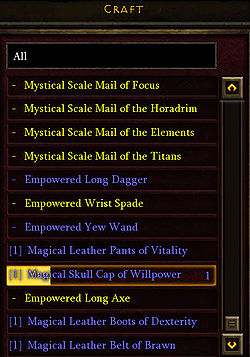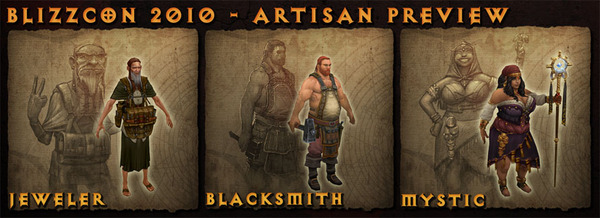Artisan
The Artisans are special kinds of merchant NPCs, introduced in Diablo III. They provide quest information, as well as numerous essential services such as crafting, item repairs, socketing and unsocketing, item enchanting, and much more.
There are three Artisans, the Jeweler, Blacksmith, and Mystic, all of whom travel with the Caravan and are available to the player in each act of the game. Artisans were introduced in August 2010, and are succinctly explained in the Artisan Video, narrated by Jay Wilson.
Contents
Overview
Artisans are basically super-vendors, buying and selling items, as well as providing all of the crafting services. They have other special features as well; they can be upgraded, which improves their skills, adds to the crafting recipes they offer, and even improves the appearance of their wagons.
Crafting is their biggest special skill. This form of item creation requires a recipe, materials, and gold, which the Artisan will craft into a new item with some pre-set and some random properties. This is essentially an upgrade over how crafting worked in Diablo II, and it varies from crafting in most RPGs since the outcome is not entirely predictable; the random properties can roll as a wide variety of modifers, potentially yielding a fantastic item, or a piece of junk, from the same recipe. Numerous attempts at most recipes are to be expected before a great item is fashioned.
When first encountered, the Artisans seem like any other NPCs. They have problems that must be solved as quests. Only once the Artisans have been impressed by the hero's skill will they join the Caravan and travel with you, offering quest and story information, as well as their talents and abilities, for a price.
Artisans can also specialize in various types of crafting. The mechanics of this aren't yet known, but Jay Wilson described the blacksmith learning to make all sorts of axes, or swords, if he specialized in those item types. This would show up in the design of his shoppe, too, with more of that type of weapon on display.
Specializing doesn't take away from the Artisan's other recipe skills though. They can still make all types of items, and can learn to specialize in multiple types of items. Presumably this would just require a lot of crafting, as the Artisans learn through experience.
The Three Artisans

There are three Artisans in Diablo III. Each of these NPCs will be encountered during the course of the gameplay, and once their quest is completed they will join up with the Caravan and travel with the player for the rest of the game. See their individual pages for many more details.
The Blacksmith
Haedrig Eamon, the Blacksmith is the only Artisan yet named. He is the first one encountered, early in Act One, and he gives the player the Salvage Cube, which is used throughout the game to break down items into materials for crafting.
The Mystic
The Mystic has not yet been named, but it's widely rumored that she might be Adria, returned in Diablo III. Her talents involve creating magical objects.
- Special Abilities: Enchanting Items.
- Crafting Specialties: Magical Weapons, Runestones, Charms, Potions, Scrolls.
Jeweler
The Jeweler is also unnamed, so far. He is said to be a greedy, avaricious fellow, who accompanies the player out of a desire for riches. He deals in gems and crafting jewelry.
Training
Artisans can be trained to higher levels, gaining a new title and improved wagon appearance each time. The maximum level is five (until the expansion?), and with each level the artisans learn new recipes to craft.
Training is not free; it costs increasing amounts of gold and materials, but players will always want to train up their Artisans, since this enables them to create higher quality items from better recipes.
Specialization
In addition to being trained up, Artisans can be specialized in creating various item types. Jay Wilson spoke on this from Gamescom, in August 2010.[1]
- Jay Wilson: After you’ve max leveled your Artisan, you can specialize them in areas. They’re not exclusive, if you want to just make axes, you don't omit the ability to make swords or armor. Each path is its own time and resource commitment. And you can specialize in item types that you like the best.
Another comment on the same issue: [2]
- Moreover, you can specialize the three Artisans. The Blacksmith, for instance, can specialize in the crafting of axes. Then you will mostly see axes lying at his stall. Those specializations will not exclude other ways, however. If you are completely specialized in the crafting of axes, you can still try to make the Artisan learn another specialization, by gathering the right recipes and resources.
How specialization will work for the Mystic and Jeweler isn't yet known; perhaps the jeweler will know hundreds of recipes for rings and amulets, but will show more recipes for jewelry with good bonuses for melee combat, or spell-casting, or whatever your character desires?
Development
Artisans were revealed in August 2010, at the Gamescom show in Cologne, Germany. Nothing was revealed about their development at that point (other than the fact that it was ongoing, with the Mystic and Jeweler not yet ready to be revealed), but during the Crafting Sanctuary panel at Blizzcon 2010, the developers shared some "making of" information about the Artisans.
Not much has been revealed about their development, but one of the Blizzcon 2010 panels spent some time on the design and development of their interface.
[[File:Artisan-interface-evolution1.jpg|center|
Mystic: crafts, wands, staves and other magical items. She can enchant items and identify them. Blacksmith: crafts armor and weaponry, add gem sockets, repairs items. Jeweler: greedy old man. Crafts jewelry, combines gems, de-socket gems for a fee. Preserves gems and items. Makes you want to use your gems, but
14 gem levels. Only the first 5 levels ever drop. Up to Radiant. Higher than that is only made by the jeweler.
Interface designer. Quick to pick up, simple to use, lets you get about your business of killing things. Want to maintain consistency of artisan interface design.
Too detailed early design. Could only show 4 items at once. 2nd try. Took off requirements listing. Now show 10 items at once. Too cumbersome. Too much info at once. Wanted to have time to craft something. Took days. Not fun in reality; testers didn't like to wait. Next version, took off the image. Took too much space. Removed the que from the bottom; progress bar behind the item.
Caravan. We knew we wanted one early on. Npcs follow chars around on quests. We wanted them to look different. Wagon design. Mystic was hard to design. We know we wanted nature themes and round stuff and wood. Early on she looked like the blacksmith. We decided to make her layout round. Jeweler: hard to figure the low vs. high level. With blacksmith can have simple weapons and then level them up. Same with the mystic. Big flaming wands, etc. But with the jeweler his items are tiny trinkets. So we had to figure how to increase the visuals. So its' the wagon. Gets bigger, more intricate details, gold plating, etc. Everyone levels up in Diablo. Even the vendors.
Media
| Characters & NPCs[e] Import. Chars Rumoured Diablo 3 NPCs Diablo 2 NPCs Diablo 1 NPCs Minor A-K Minor L-Z Fanmade |
|---|
| Important Characters |
Angiris Council Lords of Hell |
Horadrim Miscellaneous |
Miscellaneous (cont) |
Miscellaneous (cont) |
Miscellaneous (cont) |
|---|
| Diablo III's Possible NPCs |
Franklin Burroughs - Humbart Wessel - Pablo DeSoto - Quov Tsin - Kentril Dumon - Zayl |
|---|
| NPCs of Diablo II |
Act I:
Akara -
Charsi -
Chickens -
Deckard Cain -
Flavie -
Gheed -
Kashya -
Rogue NPCs -
Warriv
|
|---|
| NPCs of Diablo I |
Diablo NPCs:
Adria -
Cain -
Cows -
Farnham -
Gillian -
Griswold -
Kael Rills -
Ogden -
Pepin -
Wirt
|
|---|
| Minor A-K |
Achilios - Adria - Akara - Albord - Aldric Jitan - Alkor - Anya - Arkaine - Asheara - Assur - Atma - Augustus Malevolyn - Baerna - Banagar - Benjin - Brek - Buyard Cholik - Camylle - Celestia - Cornelius - Darrick Lang - Diomedes - Drognan - Edgewulf - Elora - Elzix - Emilye - Fara - Farnham - Fautzin - Galeona - Garda - Gheed - Gillian - Gorst - Greiz - Griswold - Guthwulf - Hagan - Halbu - Hanos Jeronnan - Hargo - Hays - Hratli - Hrothwulf - Humbart Wessel - Hunfrith - Hyram - Icharion - Jace - Jamella - Jerhyn - Jodas - Juris Khan - Justinian IV - Kabraxis - Kara Nightshadow - Karybdus - Kashya - Kentril Dumon - Kethryes - Korlic - Kreghn - Ku Y'leh |
|---|
| Minor L-Z |
Lam Esen - Larzuk - Linarian - Lysander - Malah - Mat Hu-Ring - Meshif - Mirakodus - Mordecai - Natalya - Nefriti - Nellia - Nihlathak - Nor Tiraj - Norrec Vizharan - Ogden - Ord Rekar - Orlif - Ormus - Oskal - Palashia - Pepin - Qarak - Qual-Kehk - Riordan Nesardo - Sadun Tryst - Salene Nesardo - Sardak - Sarnakyle - Septumos - Simon - Talic - Taramis Volken - Tilgar - Tobio - Toko - Tylwulf - Vischar Orous - Warriv - Wirt - Wulfgar - Xazax - Zagraal - Zayl - Zorea |
|---|




